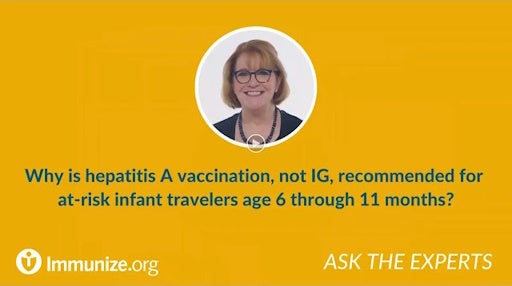For details on preexposure protection of international travelers age 12 months and older, refer to Appendix A on page 35 of the current ACIP recommendations for the prevention of hepatitis A: www.cdc.gov/mmwr/volumes/69/rr/pdfs/rr6905a1-H.pdf.
Healthy people age 12 months through 40 years who are planning travel to an area with high or intermediate HAV endemicity and have not received HepA vaccine should receive a single dose of HepA vaccine as soon as travel is considered and should complete the 2-does series according to the routine schedule.
People with chronic liver disease as well as adults older than 40 years of age, immunocompromised people, and people with other chronic medical conditions planning to depart to an area with high or intermediate HAV endemicity in less than 2 weeks should receive the initial dose of HepA vaccine and may also simultaneously be administered immune globulin (IG) at a separate anatomic injection site (for example in separate limbs).
ACIP revised its recommendations for preexposure hepatitis A vaccination for travelers in 2018 to include vaccination of infants 6 through 11 months of age. All infants of this age traveling internationally should be given a dose of measles, mumps, rubella vaccine (MMR) before travel. Due to the potential interference of hepatitis A IG with MMR vaccine effectiveness, an off-label dose of HepA vaccine is recommended instead of IG in this situation. The travel-related dose for infants 6–11 months of age should not be counted toward the routine 2-dose series. The routine 2-dose HepA and MMR vaccination series should be initiated at age 12 months according to the routine, age-appropriate vaccination schedule.
Infants younger than 6 months and travelers who elect not to receive vaccine or for whom vaccine is contraindicated should receive a single 0.1 mL/kg dose of IG before travel when protection against HAV is recommended. If travel is for more than 1 month, a dose of 0.2 mL/kg should be administered. A 0.2 mL/kg dose can be repeated every 2 months for travel of more than 2 months duration.
